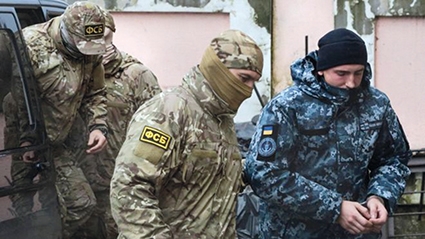Russia & Ukraine: Calm on Land, War at Sea
On November 25, Russian gunboats attacked Ukraine’s naval convoy, rammed a tugboat and seized it along with two other Ukrainian ships. The vessels were traveling from the Ukrainian port of Odessa, on the Black Sea, to the Ukrainian port of Mariupol on the Sea of Azov. The only route to access Mariupol was the Kerch Strait that separates Russian-controlled Crimea from Russia proper.
Previously, Ukrainian and Russian sailors had been causing problems for each other which often ended in temporary arrests. However, the recent events near Crimea mark a new level of escalation between the two countries. While in Donbass the situation is relatively calm, with only occasional fighting along the contact line, the overall situation points to the fact that large-scale military action is unlikely to happen in east Ukraine.
Perhaps another theater where Moscow could press Kiev is at sea, and Moscow’s actions might be a negotiating tactic or first steps towards further securing the Sea of Azov.
The sealing off of the Kerch Strait would be significant for Ukraine and specifically for its economy as it is the only route for the country’s ships to reach the ports of Berdyansk and Mariupol. A large part of Ukraine’s maritime economy depends on trade through these two ports as Ukraine’s Black Sea ports are not that competitive and it will be difficult for Kiev to re-route trade from the Azov ports to the Black Sea ones. If a veritable blockade of the Azov Sea continues, then we are likely to see a further drop in economic activity. For instance, exports entering through Mariupol already dropped 58% in recent years. Because of difficult security, foreign investment has been close to zero.
As said, this represents an entirely new level of pressure on Ukraine from Russia to cut off Kiev’s Azov trade with the outside world, as Ukraine exports more to Arab countries than to Russia.
At the same time, Russia’s actions might be regarded as a logical continuation of previous ones. The annexation of Crimea, temporary closures of the Kerch Strait as well as the construction of the bridge from the Russian mainland to the peninsula, would still not mean a total domination of the Azov Sea or straits if Ukraine’s and potentially foreign ships are allowed to sail into the Azov basin.
Russia’s drive to dominate the Kerch Strait and the Azov Sea might also reflect Moscow’s strategic thinking and concerns. The Kerch Strait is an approximately 25-mile-long channel that is no wider than 9 miles. The Strait links the Black Sea to the Azov and is important as it allows the control of water routes and energy resources coming in and out of the Azov Sea.
Thus, it was inevitable that Russia and Ukraine would fight for the territory. Indeed, there were cases even well before Russia-Ukraine relations plunged. In 2003, Russia and Ukraine nearly went to war over the strait when Russia started construction of a bridge to one of the islands in the Azov Sea.
However, following the Euromaidan Revolution in Ukraine in 2014, the dispute between Moscow and Kiev has taken a much more serious turn, seeing the two countries now battling for control of the Black and Azov seas’ military and economic communication lines.
The Kerch Strait is a continuation of the Northern Caucasus into Crimea, home to Russia's Black Sea Fleet located at Sevastopol. That is why Moscow is concerned that the pro-Western government in Kiev could potentially allow the Strait to be used by Western military fleets and even NATO. Russians want to keep direct access to the Don River safe, closed to the military alliance. Moscow also thinks that, theoretically, the strategically important Don River could be used by foreign troops to enter the Russian mainland.
As such, we need to put the Russian actions against Ukrainian ships into a wider geopolitical perspective. Yet, even if the closure turns out to be only a temporary move, Moscow is sending a clear message to Kiev on the pressure tools it has to hand to limit potential Western military encroachment on strategic routes in the Black and Azov seas.
By Emil Avdaliani
Image source: rferl.org












